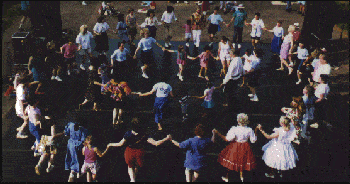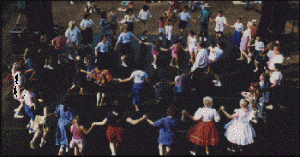
 An inventory of my essays over the past two years revealed that I’ve written mostly about the original “Ruth’s Truths,” which are my perspectives from over fifty years of a life vigorously lived. In addition, I’ve carved out a little niche in the genre of travel writing, and have expounded my always unorthodox views on education. I haven’t written much, however, about the entirely unique art form that is one of my life’s greatest passions: Israeli “folk” dancing.
An inventory of my essays over the past two years revealed that I’ve written mostly about the original “Ruth’s Truths,” which are my perspectives from over fifty years of a life vigorously lived. In addition, I’ve carved out a little niche in the genre of travel writing, and have expounded my always unorthodox views on education. I haven’t written much, however, about the entirely unique art form that is one of my life’s greatest passions: Israeli “folk” dancing.
Communal dancing had been part of Jewish cultural celebrations from the earliest historical times. Originally, the dances may have been improvised to the beat of klezmer tunes in Eastern Europe, or to the middle eastern tarbuka drums, but, over time, they turned into choreographed routines. Nearly every folk and/or popular song coming out of Israel has a particular dance to it, choreographed to it by a cohort of individuals who teach classes all over the Israel and the world.
I put the word “folk” in quotes, because the modern country of Israel brings up images that are anything but “folksy.” We are edgy, we are high tech, and, as our founding father Theodore Herzl deemed it, “old-new.” I’ll allow myself to use the pronoun “we” for the purposes of this article, although I am not Israeli. Still, I consider it my ancestral home, the way a Japanese-American might think of Japan, or a Polish-American may think of Poland. I do love it when I go there, and have written about my feelings in previous articles. The best part about going to Israel for me is the ability to engage in the dancing every day and/or night of the week.
Here in Los Angeles, we come pretty close; over the past year, our community has divided and multiplied into five different weekly dance sessions, not counting one in Costa Mesa on Sunday nights, and occasional special Saturdays. Los Angeles has in fact been a landmark location for this type of dancing since the 1958 arrival of Dani Dassa in Los Angeles, only ten years after the birth of the modern national of Israel itself. Over the years, we have at least had two nights a week of dance, if not more. Recently, however, the community has experienced a shift, with the arrival on the scene and/or coming of age of a few dynamic teachers and choreographers, such as Orly Setareh and Sagi Azran, and the retirement of older statesmen such as David Dassa and Israel Yakovee. I dedicate this essay to the old guard and the new, as the torch is passed to the youngins.
In Israel, our dancing is known to attract the older set. In most parts of the world as well, I’d say the average age of a dancer is mid-fifties. This makes sense given the age of the nascent nation itself, and the fact that doing this type of dancing at one’s college Hillel organization was part of the zeitgeist of a 50-something Jewish-American. Many of the (still) married couples on our community met in or shortly after college on the Israeli dance floor.
Jews and others flock to this pursuit for exercise, relaxation, socialization, and spiritual connection. The dances might be high energy. As a visitor once noted, “Hey, running is actually part of a dance?!” Or, they may be waltz-like ballads. There are line dances, just like country line dances. The most unique feature to this genre are the circle dances, and then there are the now prevalent “ballroom-like” partner dances, with lead and follow roles that are often different, complicated, and require a relatively steep learning curve.
I don’t mean to stereotype, but if I may wax general about my own people, I would state that we tend to get bored with the limited moves of improvised dance, yet salivate for ever new arrangements we can crunch our heads around and memorize. Many of us tend to be shorter in stature – not that it should matter, but, as cerebral, often nerdy, geeky and sometimes even “on the spectrum” (before we knew what “the spectrum” was), we were not always the first to be picked on the basketball team. In fact, if we had been picked first for basketball in junior high school, we probably wouldn’t be doing Israeli dancing now. We actually happen to have a group of geezers within our community who meet for a weekly pick-up game; they call it, “basketball for the rest of us.”
Of constant consternation to us is the fact that there tend to be more women than men who come to dance, and competitive feeding frenzies ensue over possession of a male – any male – partner. Some women will dance with each other in the separate gender roles of the dance, but, imagine this: any man needing an ego boost need look no further than the Israeli dance floor; you will be adored, beloved, coddled, desired, enticed, feted, grabbed, hugged, invited, joined, kissed, loved, manhandled, noticed, optioned, pursued, quested, respected, sought, touched, used, valued, wanted, and XYZ’d.
We all have tons of opinions about how our sessions should be run. The lessons are too advanced, or too remedial, the room is always too hot, or too cold. The original songs are cut to exclude any superfluous choruses, and if a song of is so long that the dancers would have to do a sequence more than twice, the song is further reduced. The music is played super loud, to create a sense of excitement, I guess, so people wear earplugs to block it out, then can’t hear each other’s careless whispers during a dance. Our garb is mostly yoga pants and dry-fit halters for women and jeans and sports T’s for men, and dance sneakers.
In the final analysis, it becomes an addiction. Never enough of the music we love, of the dances we know, of the people we see weekly, even daily. Never enough Israeli dancing.
****************************
My essay above is exactly 1000 words, as usual. But I would like to share a poem I was inspired to write on the topic of Israeli dance the other day. Using some of what I have taught in the classroom, I have combined the five senses of descriptive prose writing with the five questions of investigative reporting to create this short poem:
With others in the circle, feeling my neighbor’s hand in my palm: reliant
The smell of sweat, breath, cologne, deodorant, chewing gum: faint
Entering, eyes scanning a room filled with loves, and hates
Making my way to the center when confident, hanging back in the hinterlands when I’m not.
He palpable success of knowing that I know how to do what I do.
Hearing the notes, so familiar that you…
Can’t leave when they play your song, even though you will surely hear it again next time.


Be the first to comment